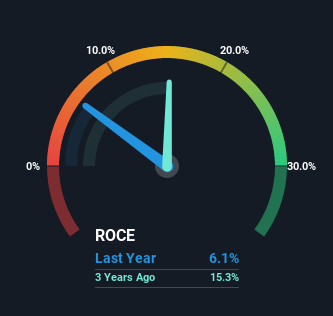- Hong Kong
- /
- Construction
- /
- SEHK:1459
Jujiang Construction Group (HKG:1459) Will Want To Turn Around Its Return Trends

If you're not sure where to start when looking for the next multi-bagger, there are a few key trends you should keep an eye out for. Firstly, we'd want to identify a growing return on capital employed (ROCE) and then alongside that, an ever-increasing base of capital employed. Ultimately, this demonstrates that it's a business that is reinvesting profits at increasing rates of return. In light of that, when we looked at Jujiang Construction Group (HKG:1459) and its ROCE trend, we weren't exactly thrilled.
Understanding Return On Capital Employed (ROCE)
If you haven't worked with ROCE before, it measures the 'return' (pre-tax profit) a company generates from capital employed in its business. The formula for this calculation on Jujiang Construction Group is:
Return on Capital Employed = Earnings Before Interest and Tax (EBIT) ÷ (Total Assets - Current Liabilities)
0.061 = CN¥109m ÷ (CN¥6.5b - CN¥4.7b) (Based on the trailing twelve months to December 2022).
So, Jujiang Construction Group has an ROCE of 6.1%. On its own, that's a low figure but it's around the 6.9% average generated by the Construction industry.
Check out our latest analysis for Jujiang Construction Group

Historical performance is a great place to start when researching a stock so above you can see the gauge for Jujiang Construction Group's ROCE against it's prior returns. If you'd like to look at how Jujiang Construction Group has performed in the past in other metrics, you can view this free graph of past earnings, revenue and cash flow.
So How Is Jujiang Construction Group's ROCE Trending?
When we looked at the ROCE trend at Jujiang Construction Group, we didn't gain much confidence. Over the last five years, returns on capital have decreased to 6.1% from 17% five years ago. Given the business is employing more capital while revenue has slipped, this is a bit concerning. If this were to continue, you might be looking at a company that is trying to reinvest for growth but is actually losing market share since sales haven't increased.
On a separate but related note, it's important to know that Jujiang Construction Group has a current liabilities to total assets ratio of 72%, which we'd consider pretty high. This effectively means that suppliers (or short-term creditors) are funding a large portion of the business, so just be aware that this can introduce some elements of risk. While it's not necessarily a bad thing, it can be beneficial if this ratio is lower.
In Conclusion...
In summary, we're somewhat concerned by Jujiang Construction Group's diminishing returns on increasing amounts of capital. Long term shareholders who've owned the stock over the last five years have experienced a 28% depreciation in their investment, so it appears the market might not like these trends either. That being the case, unless the underlying trends revert to a more positive trajectory, we'd consider looking elsewhere.
One more thing: We've identified 4 warning signs with Jujiang Construction Group (at least 1 which can't be ignored) , and understanding them would certainly be useful.
While Jujiang Construction Group isn't earning the highest return, check out this free list of companies that are earning high returns on equity with solid balance sheets.
New: Manage All Your Stock Portfolios in One Place
We've created the ultimate portfolio companion for stock investors, and it's free.
• Connect an unlimited number of Portfolios and see your total in one currency
• Be alerted to new Warning Signs or Risks via email or mobile
• Track the Fair Value of your stocks
Have feedback on this article? Concerned about the content? Get in touch with us directly. Alternatively, email editorial-team (at) simplywallst.com.
This article by Simply Wall St is general in nature. We provide commentary based on historical data and analyst forecasts only using an unbiased methodology and our articles are not intended to be financial advice. It does not constitute a recommendation to buy or sell any stock, and does not take account of your objectives, or your financial situation. We aim to bring you long-term focused analysis driven by fundamental data. Note that our analysis may not factor in the latest price-sensitive company announcements or qualitative material. Simply Wall St has no position in any stocks mentioned.
About SEHK:1459
Jujiang Construction Group
Provides construction contracting services for residential, commercial, industrial, and public works in the People’s Republic of China and Hong Kong.
Adequate balance sheet slight.
Market Insights
Community Narratives



